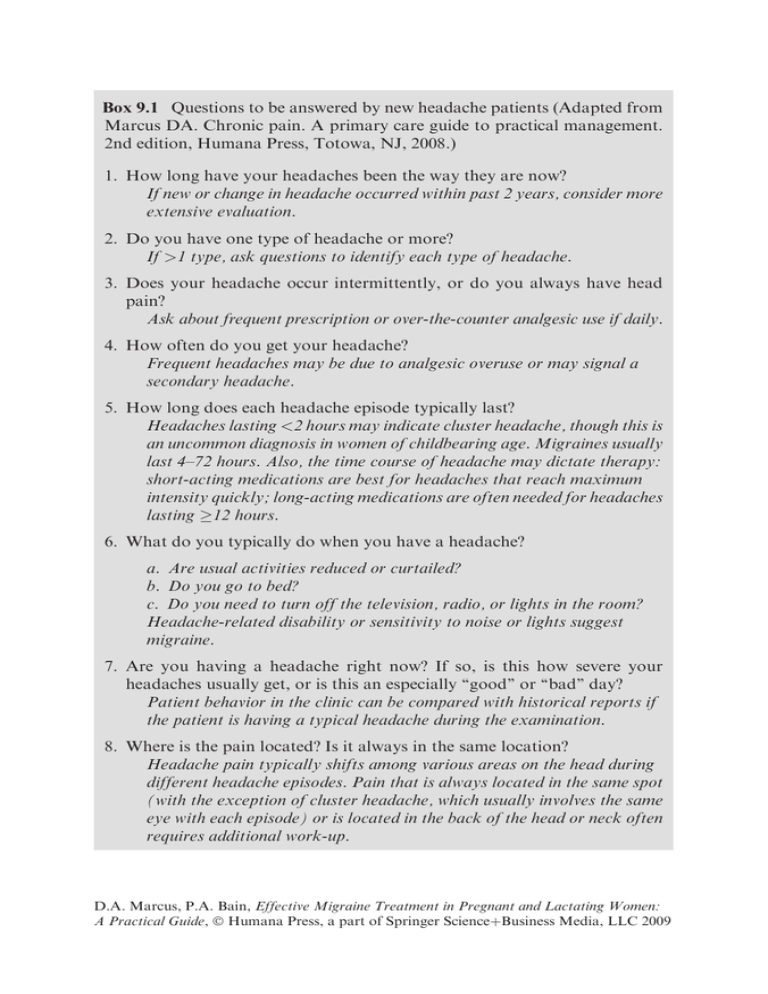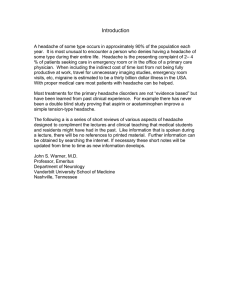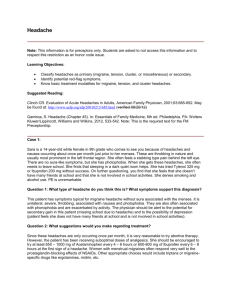Box 9.1 Questions to be answered by new headache patients... Marcus DA. Chronic pain. A primary care guide to practical...
advertisement

Box 9.1 Questions to be answered by new headache patients (Adapted from Marcus DA. Chronic pain. A primary care guide to practical management. 2nd edition, Humana Press, Totowa, NJ, 2008.) 1. How long have your headaches been the way they are now? If new or change in headache occurred within past 2 years, consider more extensive evaluation. 2. Do you have one type of headache or more? If >1 type, ask questions to identify each type of headache. 3. Does your headache occur intermittently, or do you always have head pain? Ask about frequent prescription or over-the-counter analgesic use if daily. 4. How often do you get your headache? Frequent headaches may be due to analgesic overuse or may signal a secondary headache. 5. How long does each headache episode typically last? Headaches lasting <2 hours may indicate cluster headache, though this is an uncommon diagnosis in women of childbearing age. Migraines usually last 4–72 hours. Also, the time course of headache may dictate therapy: short-acting medications are best for headaches that reach maximum intensity quickly; long-acting medications are often needed for headaches lasting 12 hours. 6. What do you typically do when you have a headache? a. Are usual activities reduced or curtailed? b. Do you go to bed? c. Do you need to turn off the television, radio, or lights in the room? Headache-related disability or sensitivity to noise or lights suggest migraine. 7. Are you having a headache right now? If so, is this how severe your headaches usually get, or is this an especially ‘‘good’’ or ‘‘bad’’ day? Patient behavior in the clinic can be compared with historical reports if the patient is having a typical headache during the examination. 8. Where is the pain located? Is it always in the same location? Headache pain typically shifts among various areas on the head during different headache episodes. Pain that is always located in the same spot (with the exception of cluster headache, which usually involves the same eye with each episode) or is located in the back of the head or neck often requires additional work-up. D.A. Marcus, P.A. Bain, Effective Migraine Treatment in Pregnant and Lactating Women: A Practical Guide, Ó Humana Press, a part of Springer ScienceþBusiness Media, LLC 2009 9. Any other new problems since the headache began? Identification of new medical (e.g., fever, weight loss, or other constitutional or system complaints) or neurological symptoms will suggest the need for additional evaluations. 10. Do you have family members with similar headaches? Migraine headaches often run in families. If one parent has migraine, his or her child has a 50% chance of developing migraines. If both parents have migraine headaches, this risk increases to 75%.




